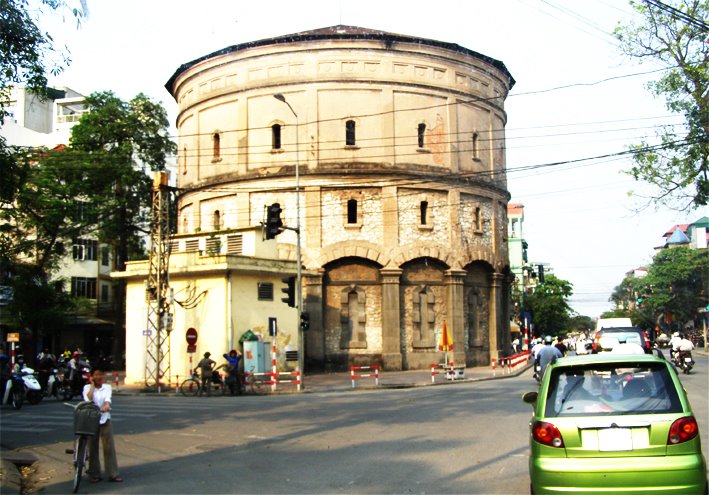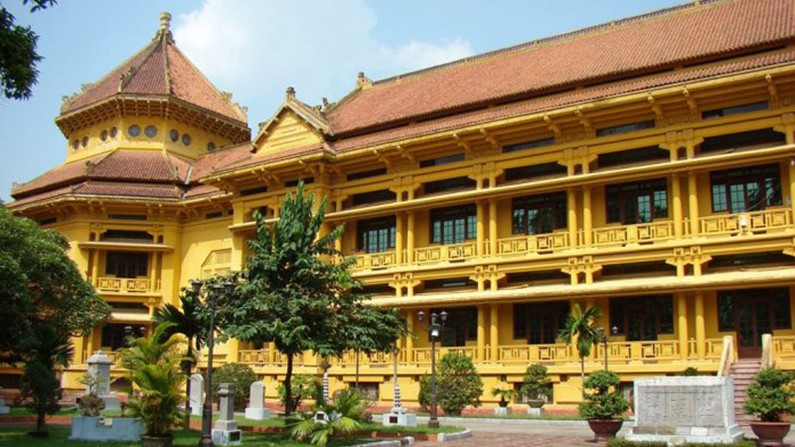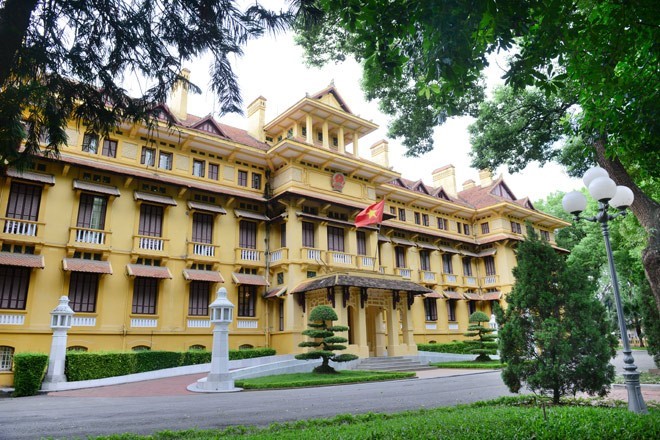– The Presidential Palace, University of Hanoi, Hang Dau water tower, and Hospital K are fourof several French colonial buildings in Hanoi that have been proposed for preservation.
Hanoi Opera House

The theatre is located at No.1 Trang Tien street on the August Revolution Square, the center of Hanoi, near Hoan Kiem Lake and the Vietnam History Museum.
The 2,600m2 theatre was designed by two French architects Harlay and Broyer. The construction took place from 1901 to 1911.
It’s a phenomenal piece of neo-classical French architecture featuring Gothic themes on the doors and domes with pillars, shuttered windows, balconies and a glass room.
There are 3 main parts in this building: the lobby, the main audience room and the mirror room. The main lobby is the first place welcome visitors enter the theatre. It was made with high-quality stone of Italy. All small chandeliers are brass and look luxurious.
Inside the opera house are a large stage and a main audience room with a size of 24x24m, with many small rooms for audiences on the central floor.
At the back of the Opera House is a management chamber consisting of 18 make-up rooms, two rooms for voice training, a library and a meeting room.
The Main Audience is paved with high quality tiles and fireproof carpet. Seats are designed in classical French style of the nineteenth century. The mirror room is the ritual room that has welcomed many high-ranking officials.
The Hanoi Opera House is the biggest theatre in Vietnam and speaks volumes as historical and cultural evidence of Vietnam under French rule. The interior is even more magnificent than the exterior with many arguing it is aesthetically even more appealing than the Paris Opera House.
Visitors today will be entertained at this architectural landmark which features a range of events including local Vietnamese opera, traditional folk music, ballets and many international concerts.
Following the end of the August Revolution in 1945, The Hanoi Opera House reverted from entertaining the French elite to becoming the centre of major historical events including the first session of the National Assembly of the Republic. The Hanoi building went into a state of decline prior to being renovated and brought up to date in 1997, which included the installation of state-of-the-art equipment and renewal of some of the interior decorations.
Hang Dau water tower

This water tower was built in 1894, before Long Bien Bridge, and is located at the crossroads of Hang Than, Hang Luoc, Hang Giay, Hang Dau, Quan Thanh and Phan Dinh Phung streets.
This water tower was the first work marking the transformation of Hanoi into an urban center. Previously, Hanoians used well water or water from lakes and ponds.
This water tower has become a special landmark in Hanoi, just like Hoan Kiem Lake or the Old Quarter. During the wars, the tower was not hit, but in the 1960s, it stopped working.
For years, the tower was surrounded by many stalls, but in 2003, these stalls were closed. The ancient water tower stood in its original form until early April 2010, when the tower was refurbished.
Vietnam National Museum of History

The National Museum of Vietnam History was founded on the material basis of the Louis Finot, a museum of the Ecole Française d’Extreme-Orient (French School of the Far East) which was built in 1926 and completed in 1932.
In 1958, the Vietnam Government officially took over this cultural building and started to research, collect and supplement materials and objects, converting the contents from eastern arts into national history. On 3 September 1958, the National Museum of Vietnam History was officially opened for visitors.
The main exhibition system is the vivid historical book of Vietnamese nation from the prehistory (about 300,000-400,000 years) to the August 1945 Revolution. With an exhibition area of over 2,200 square meters and nearly 7,000 original artifacts, the main exhibition system is arranged chronologically
The basic storehouses now keep more than 100,000 specimens and artifacts of different materials, including many rare and valuable items, especially the collections of objects dating back the ancient cultures (Hoa Binh-Bac Son, Dong Son), Vietnamese ancient glazed ceramics, Champa stone sculptures, and bronze items under the Le-Nguyen Dynasties.
The museum is situated at the back of the Hanoi Opera House. It is in 1 Trang Tien Street, 216 Tran Quang Khai Street, Hanoi.
The Government Guesthouse

This elegant building was built in the French architectural style. It is located on Ngo Quyen Street, a short distance from the Sofitel Metropole Hotel.
The Government Guesthouse was formerly the Residence of the French Governor of Tonkin. Tonkin is the historical name for northern Vietnam.
After the August Revolution in 1945, this building was the headquarters of the government of the Democratic Republic of Vietnam, where President Ho Chi Minh worked from August 1945 to December 1946. Today it is used as the guesthouse for VIP visitors of the government.
Chu Van An High School
.jpg)
The school was established in 1908 by the French with the name Lycée du Protectorat for the purpose of training personnel for the ruling apparatus of France in Northern Vietnam. In addition, it was known as Buoi School or Chu school. Hanoi people often call it Buoi School because it was located in Ke Buoi area. Not only that, the name "Buoi School" is also how students express their patriotism in the French colonial period. In 1945, it was renamed national high school of Chu Van An and that name has been maintained until now.
This school is known as abeautiful school bearing the hallmark of the French. Octagonal Building is the most outstanding structure in Chu Van An School. The structure used to be Schneider Villa (La villa Schneider), named after the host of the villa Henri Schneider, a French owner of a paper shop. There was a time the building was unoccupied and seriously damaged. In 1999, with the financial aid from le-de-France region in France, the Octagonal Building was repaired and used as school library. Nowadays, this building is an impressive architectural structure on the side of West Lake.
Presidential Palace

Presidential Palace in Hanoi is a three-storey structure located on the north of Ho Chi Minh Mausoleum. Presidential Palace stands as a memento of French contribution to the architectural splendor in Indochina. This mustard-yellow palace was built from 1900 to 1906 to function as the living and operational bases of the governors-general of Indo-China. Located on Hung Vuong Street and Hoang Van Thu Street, the designs of this palace were conceived by Auguste Henri Vildieu, the French architect officially appointed for Vietnam. In 1945, the building was renamed Presidential Palace.
The Palace is still the Palace for the President. It is used mostly in national ceremonies or national receptions for diplomats and foreign leaders.
The architecture is a mirror of the French essence. The only tropical character of the villa is the surrounding mangoes. The Renaissance style is reflected in the aedicule, a formal piano reached by a grand staircase, and broken pediments, classical columns and quoins. The interior is lavish. The Grand Ceremony Room is designed in accordance with the King Louis XIV. Meanwhile, the Grand Dining Room is of the Renaissance. Lastly, the private room of the General Governor reflects the ambience of French Emperor style. Of course, each General Governor sometimes ordered renovation. The Palace has a timeless beauty beyond time and space.
Foreign Ministry’s building

The building of the Ministry of Foreign Affairs’ headquarters in Hanoi was recognized as a national relic site this August.
The building, having a hundred clay-tiled pitched roofs, is situated in Ton That Dam Street at Chu Van An - Dien Bien Phu crossroads. It used to be the headquarters of the Indochina Ministry of Finance and has become the headquarters of the Vietnamese Ministry of Foreign Affairs from October 3, 1945.
The building was designed by French architect Ernest Hebrard in 1924. Its construction work began in 1925 and was completed in 1928. As other buildings he designed, it bears his distinct Indochine Style, which blended Eastern and Western traditions.
Hanoi National University

The University of Natural Sciences and University of Medicine is the same location as Hanoi National University (1956) and Indochina University (1926) designed by the French architect Ernest Hébrard. Seen from Ly Thuong Kiet Street, the university was built over four years (1923-1926), following Indochina architecture style and having the interference of Asia and Europe. The multi-layered roof system is octagonal. Among layers of roof are small doors decorated with flower patterns.
Hospital K

To meet the requirements of cancer treatment of the people in Indochina, a French private organization entitled Indochina Radium Institute was launched in Hanoi on October 19, 1923, managed by Pierre Moullin.
An Institute was based in the two-storey building with sides facing Trang Thi, Quan Su and Hai Ba Trung streets (built during 1915-1920). The name Institut du Radium de L'Indochine remains until today.
The name was changed to the National Cancer Hospital in July 1969.
Nhận xét
Đăng nhận xét